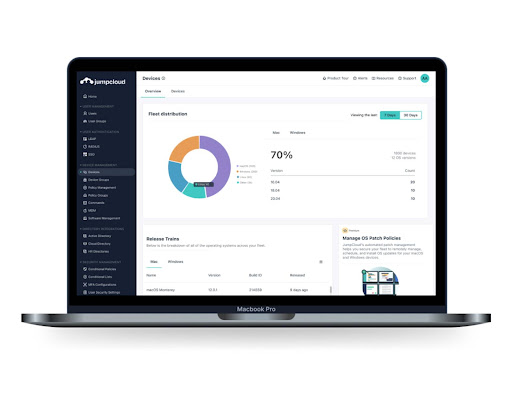Note: this article is a prelude to our upcoming webinar Mental Health for IT Admins: Helping the Helpdesk. Join Rick Ginsberb, psychologist, and Ricky Jordan, senior technology manager of Primitiveskate, on November 3rd at 12:00 p.m. EST for tips for how to reduce stress.
It was my first job.
I was 22 years old, and my life looked nothing like a Taylor Swift song.
My “dream job” had slowly turned into a Groundhog Day nightmare.
The prestige of having a downtown parking permit, eating lunch at the state capital, and making media lists at a public relations agency had worn off faster than the heels of my bargain, leather boots. The inconvenient reality: I was approaching burnout.
Abruptly switching from the rigors of academia to the monumental responsibility of making coffee proved jarring. Feelings of restlessness, boredom, and despondency began to brew. Sadly, I feared bringing up these feelings with my employer. “What if they say I’m ungrateful for this opportunity I had enthusiastically rallied for?” I thought.
According to a 2022 Microsoft survey, my experience wasn’t unique. The survey revealed 48% of employees and 53% of managers report feeling burnt out at work.
In this article, I’ll share some information I wish I would have received in my early career. I’ll also share some specific tips for IT admins seeking better work-life balance.
What Is Burnout?

The Mayo Clinic defines job burnout as:
A special type of work-related stress — a state of physical or emotional exhaustion that also involves a sense of reduced accomplishment and loss of personal identity.
It’s important to emphasize that burnout isn’t a medical diagnosis. However, experts agree that factors like depression, personality traits, living environments, and long hours can contribute to its onset.
With that said, Microsoft identified two types of burnout: the first type involves disengagement from one’s job (like in my story) and the second type describes chronic depletion impacting all areas of one’s life.
Health insurance provider Cigna says major job stress can result from “having too much work, not enough work, or doing work that doesn’t satisfy you.” Whatever the cause, establishing good mental health habits is crucial for long term well being.
What Does Burnout Look Like for IT Admins?
According to a 2021 CIO Insights Report, 77% of IT admins described their jobs as stressful. Our friend Jake, an enterprise linux systems administrator, certainly did at one time. In this article for RedHat, he describes his experience of pushing himself too hard:
“I really didn’t notice it taking a toll on me at the time but, looking back, I started showing symptoms of burnout fairly early,” Jake says. “However, it was easy to push aside with the excitement of moving to new roles with increasing responsibility and continuing my aggressive pursuit of learning. Before I knew it, several years had passed and I was officially burnt out.”
Jake says one of his earliest signs of burnout was a decreased interest in technology. At the onset of his career as a sysadmin Jake loved tinkering in his home lab to experiment with new products, reading new documents, and applying newfound knowledge.

Of course, no job is without its occasional stressful moments. Different roles produce various types of pressure, challenges, and circumstances.
Admins, in particular, may struggle with:
- Establishing clear boundaries and protocols for user requests
- Juggling several tight deadlines at once
- Lacking focus (due to continuously switching tasks)
- Blurring lines between work and home
- Staying abreast of new technologies
Be on the lookout for these common early signs of trouble and adjust accordingly.
4 Tips for Improving Mental Health
Let’s look at some things admins can do to support their mental health and prevent burnout:
1. Stop Masking Your Emotions
This one may take some practice and a hefty dose of courage to execute. But one of the quickest ways to improve one’s mental health is to relieve yourself from the pressure of masking.
Masking is the psychological term for concealing real-time emotions by portraying more socially acceptable ones. Understandably, it sometimes feels easier to act like everything is fine when it isn’t. But masking over a long period eventually becomes downright exhausting.

As Dr Margie Warrell, Forbes columnist, says:
In a culture that celebrates positivity, the overgeneralization of ‘think positive’ to all situations can be harmful as it denies the full human experience… To downplay, deny or dismiss those not-so-good feeling emotions denies the full human experience.
Does that mean you should hold a therapy session with everyone you come across? No, but giving yourself permission to say you’re having a stressful moment can take a huge load off your shoulders. It also makes you appear more relatable to your colleagues.
2. Reduce Tool Sprawl
Based on our daily conversations with admins, most of them seem to switch back and forth between a minimum of six different solutions a day. Constantly navigating between several tools in a short amount of time – MDM, RDM, IAM, password management, etc.— can quickly create mental fatigue.
According to a 2021 Cornell University report, individuals take 9.5 minutes on average to resume a productive workflow after switching between digital apps. Todd Waits of the Carnegie Mellon Software Engineering Institute borrows the computing term “context switching” to describe this inconvenient reality:
From a human workforce perspective, context switching is the process of stopping work in one project and picking it back up after performing a different task on a different project. Just like computing systems, human team members often incur overhead when context switching between multiple projects.
Beyond simple task batching, IT admins can make things easier on themselves by consolidating their toolkits whenever possible. The JumpCloud Directory Platform consolidates several of the tools admins depend on behind a single pane of glass. Jumpcloud is an elegant IAM, MDM, and SSO all-in-one solution.

If you’re looking for a 100% cloud-based platform to quickly provision/deprovision users, control data and application access, monitor activity for compliance, and more, we invite you to sign-up for a free trial today.
3. Practice Mindfulness
At this point, we’ve all heard of mindfulness. Though it may sound like an overly simplistic solution for managing stress, the practice is extremely powerful once mastered.
Mindfulness is the ability to maintain moment-by-moment awareness of our thoughts, feelings, bodily sensations, and surrounding environments — without judgment or resistance. That last part is the crucial aspect of mindfulness most people and online articles miss.
As the saying goes, “What we resist persists.” Research shows most people spend 47% of their waking hours thinking about something other than what they are doing. Having several tabs open in your mind’s browser just creates a lot of unnecessary stress.
The solution is to approach each task with your full attention. You can notice any conflicting thoughts that arise and tag them before refocusing.
Examples of thought tagging categories include past thought, future thought, fear thought, dialogue, and image. Over time, this gives your mind the message that you are in control and these thoughts are of little importance.
In addition, consider scheduling a brief awareness break during your day. Here’s an example of what that may look like:
- Close your eyes and take 5 deep breaths (longer on the exhalation).
- Open your eyes and look around the room.
- Notice 5 objects without commentary.
- Notice 5 sounds without commentary.
- Notice 5 external sensations without commentary.
- Close your eyes and scan your body.
Your mindfulness break can be as short as 5 minutes or as long as you desire. The more often you connect with your body, and detach from your thoughts, the more relaxed you will feel throughout the day.
4. Unplug During Lunch
Do you eat lunch at your desk everyday? If so, you’re definitely not alone.
Many of us enjoy eating leftovers while watching our favorite YouTube channel for rest and relaxation. But the temptation to answer a quick question or complete a “quick task” that comes in is often too great to ignore.
For this reason, try completely unplugging and moving to a separate location for lunch. Whether that be outside on a bench, in another room of your house, or a coffee shop. During this time, put your phone away and on silent.
In addition to nourishing your body, lunch is a great time to catch up with colleagues and friends. Completely unplugging for at least 30 minutes will likely provide a significant boost in energy.
Prioritize Your Mental Health — You Deserve It
Admins are accustomed to helping others before helping themselves. The very nature of the job is to support others in their moments of stress. But that should never come at the expense of your personal well being. The reality is more organizational leaders need to initiate conversations about mental health and set positive examples.Are you looking to connect with other IT admins? Join us November 3, 2022 for our upcoming webinar Mental Health for IT Admins: Helping the Helpdesk. Psychologist Rick Ginsberb and Technology Manager Ricky Jordan will be sharing more practical habits for peace of mind.




